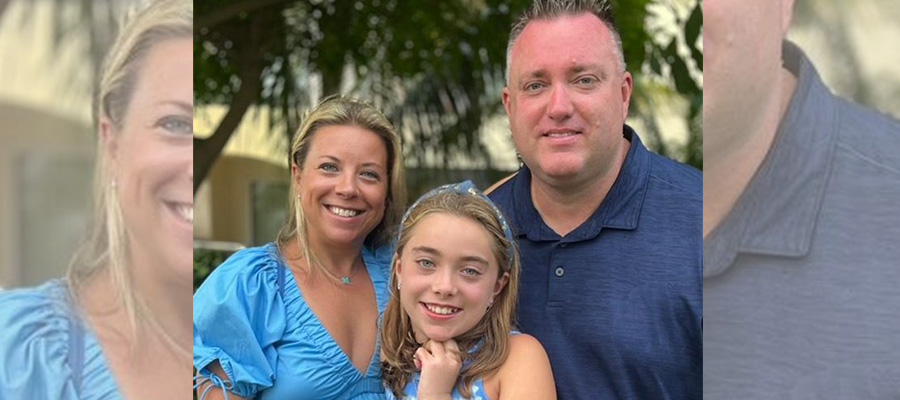
My husband and I were talking about my condition one evening several months ago in the kitchen as we put away our dinner dishes.
“I’m breaking up with women’s healthcare!” I exclaimed.
My husband, the problem solver and love of my life, quickly went into action mode.
“Find the best hospital for your case and we’ll go there,” he insisted. “I don’t care where it is.”
As I took his words to heart and began my nationwide search, now at 41 years old, I reflected on how I’d gotten to this moment.
I had my first female health experience at 17. I sat in an OBGYN waiting room due to the pain and severe bleeding I had each month during my period. My OBGYN’s solution? A hormone birth control shot called Depo-Provera. It caused spotting for 90 consecutive days. I’d become a teenager in hormonal hell, and my twenties would be no different. I spent most of that decade trying to control my heavy bleeding and pain, which I managed with birth control pills.
At 28, when my husband and I wanted to start a family, my body was a mess from a decade of hormones. With doctors telling me nothing was wrong and to “just give it time,” I turned to alternative medicine. After a few months of acupuncture and a bit of universe magic, our daughter was naturally conceived and healthily delivered.
When she was almost two, we were ready to expand our family, but months of trying to conceive turned into a year with no luck. My OBGYN prescribed Clomid, which is used to treat irregular or absent ovulation, but after another year, nothing had changed. This was when I began searching for the best reproductive endocrinologist I could find. It was the start of an eight-year journey.
We spent the first few years hearing the word “unexplained.” As our daughter moved from diapers to pull-ups to full independence starting in kindergarten, we entered the world of fertility clinics and injectable hormones with monitoring, testing, and more people in the room than I was comfortable with for such an intimate experience.
The cost? Emotional stress from late-night debates with my husband, too much time spent online searching for answers, medical bills, and time away from our growing girl.
While we believed this venture into modern-day medicine would lead us to success, I instead was poked and prodded, fueled by hormones, and suffering multiple miscarriages in the first trimester. Eventually, doctors told us the only way we’d get pregnant was through IUI and IVF. We believed it was our only hope.
On a gray October day in 2021, pregnant after our first IVF round, I started to spot. Two days later, I bled. I called my reproductive endocrinologist, who said my insurance did not allow additional care and I needed to see an OBGYN.
So, I called my OBGYN, who said, “Do you want me to order you a lab and ultrasound? Will that make you feel better?”
It was the absolute worst question by a doctor ever made to a woman starting to miscarry.
I returned to my reproductive endocrinologist, who referred me to a new OBGYN, who sent me straight to the ER.
With my husband a flight away on business, I sat in an ER with a friend, bleeding for hours, until I was finally taken back for an ultrasound. When completed, I sat in a wheelchair, bleeding alone in an empty hallway for over an hour. And that wasn’t even my lowest point.
No, the lowest point was when I was sitting alone in that hallway and opened my email to find a message from the hospital’s MyChart system. It said, “No fetal heartbeat.”
That’s how I found out.
“I’m bleeding in an ER lobby while reading that my baby is gone with no one taking me back to tell me the news!” I screamed to the person at the ER lobby desk. To prevent a further scene, they took me to a room where I sat bleeding on a bed.
When I asked for pads, they didn’t have any. When they wanted to examine my bleeding, they had me put my butt on a bedpan because they didn’t have a bed with stirrups.
How can an ER not be adequately prepared for a woman experiencing a miscarriage? I still wonder today. How can a woman be left to bleed in a hallway? To find out through email that she had a miscarriage? To be, in the simplest terms, treated so inhumanely?
As I prepared for a D&C the next day, calls to my medical insurance added pain to the already unbearable situation by requiring the OBGYN, whom I’d just met, to perform the procedure instead of my reproductive endocrinologist, who was ready to do so and had cared for me for months. Insurance drove the decision, causing me to spend the day grieving on the phone instead of in bed and with family.
The cost? A complete loss of dignity because of how I was treated from start to finish. And the pain of listening to my eight-year-old daughter cry for an hour straight when I got home from the D&C as she mourned our loss.
Soon after the D&C, my OBGYN’s office called to see how I was doing.
“Terrible, but managing,” I said.
That changed a year later when I began having panic attacks and anxiety. I called my OBGYN, who said a referral was in the system for a psychologist to contact me. Days went by without contact. I finally called again, only to find out the provider was away for the summer.
Again, I was on my own.
I saw a random psychiatrist who took a thick book out of her drawer, read me three different prescriptions, and asked, “So, what are you comfortable with?” I left, and nobody else could see me for three months. Ninety days and nights of panic attacks, anxiety, insomnia, and a constant feeling of fear to get into my bed, where the losses began.
This brings me back to the kitchen a few months ago when my husband and I were putting away the dishes.
Fueled by years of doctors, tests, hope, and loss, my break-up notion for women’s healthcare felt every bit justified. Along with the losses we suffered, I would be diagnosed with an ulcer from my nights of insomnia and crying myself to sleep. One doctor suggested that I could have adenomyosis but that it could only be fully diagnosed by removing my uterus for pathology. After my last miscarriage, I was diagnosed with PTSD. And I spent more days than not over those years nauseous, woken up in the middle of the night feeling like someone was clawing at my uterus, unable to wear regular pants due to bloating that made me look four months pregnant, and in so much pain that it hurt to walk.
The cost? A quality of life that caused me to cancel birthday parties, end gatherings at our home early because of the pain, and wear what was essentially a diaper to bed to keep the blood off our sheets. Another cost was the memories of how shaken I was every day. My mental breakdown was so severe that my husband had a vasectomy to alleviate my panic that I could get pregnant and experience tragedy all over again.
So, when my husband told me to find the best doctor, I thought I had—the chief of a nationally known hospital who was highly sought after. The result? A judgmental doctor who read all my notes but didn’t listen to me. She concluded that I probably had adenomyosis and chose to address all of my issues with… pills.
A pill for the adenomyosis.
A pill for anxiety.
A pill for pain.
And all without examining me.
In search of another “best” doctor, I finally found one in Illinois who, at the first appointment, ran tests, examined me, asked questions, listened to every response from my husband and me, and mapped out a course of treatment. Her preoperative diagnosis was adenomyosis and potentially endometriosis. In eight years of my journey, I had my very first pelvic pain examination and first MRI that showed I also likely had endometriosis.
It took eight years and more than 10 doctors for someone to listen to me.
This past January, I underwent a hysterectomy to remove my uterus, cervix, and tubes to treat the adenomyosis, and excision surgery to treat the endometriosis. At my post-op visit, I was told adenomyosis was the cause of our losses. It took eight years to get closure for something that hardly anyone knew about, from physicians to friends to me.
The cost? Lost time at work, lost time with family, a lot of money, and my physical and emotional well-being.
As I was being put under for surgery, the fellow wrapping her hand around mine said, “We’ve got you, Jamie. You’re going to be alright.” I wish I had met that hand sooner.
I share my story so we may be better equipped and fight for better diagnostic testing, treatment options, and research for women’s health. Adenomyosis and endometriosis require invasive diagnostic testing to accurately diagnose. Birth control cannot be the only “solution.” My daughter is now 11, and I worry that she, too, will experience a healthcare system that tries to throw bandages on symptoms instead of finding the root cause.
Maybe this story resonates with you, a relative, or a friend. Perhaps you have a daughter and are worried she will experience some of the things that I have. We live in one of the wealthiest countries in the world, yet women’s healthcare is lacking. The time to diagnosis and the right course of treatment is taking way too long, leaving women silently battling disease month after month.
I am part of the untold stories that women are carrying every day. I am one in four (miscarriages). I am one in 10 (endometriosis) with an average of seven to 10 years to diagnosis. I am one in five (adenomyosis), with a definitive diagnosis only with the removal of the uterus. I am one in 10 (secondary infertility). Each sentence here starts with “I.” Let’s make sure our healthcare begins with “I,” the patient, too.
The cost without it? The ability to live our lives the way we deserve.
*Patient stories submitted to EndoFound.org are the patient's views, not necessarily those of the foundation. All testimonials are from real patients, may not reflect the typical patient’s experience, and are not intended to represent or guarantee that anyone will achieve the same or similar results.









